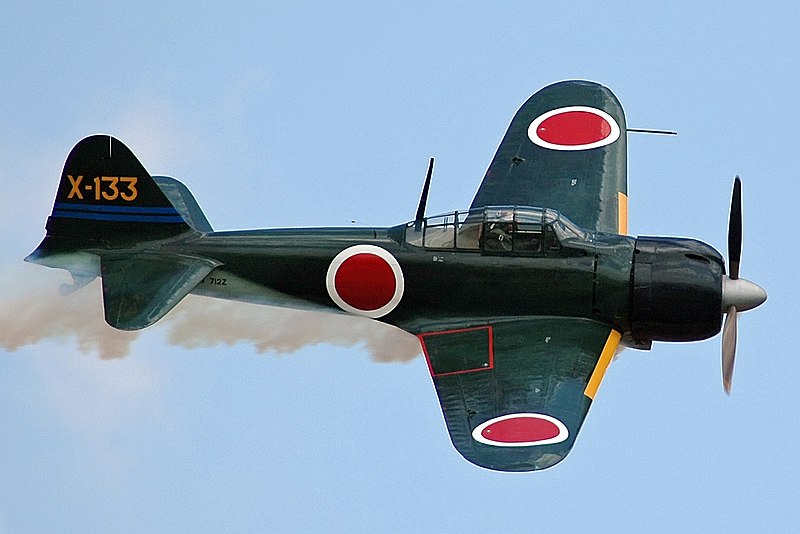Frank played the Imperial Japanese Navy, and I had the United States Navy. We played the Basic Game with the Tournament Game fighter rule added. We elected not to require the Japanese to reduce Midway before the invasion (because we agreed that it was a complication that made the Japanese position too difficult) and not to have surface combat (because that's just stupid in a carrier battle).
 |
| PBY Catalina - USN photo |
We were able to find each other immediately upon daybreak of 4 June, which turned out to be a bloody morning indeed. He had united the entire Japanese fleet - carriers and invasion force - except for two light cruisers for reconnaissance. Our strike pilots must have waved to one another as they passed above the Pacific, each seeking to deny the other a place to land when the fight was over. We had each split our fighters fairly evenly between Combat Air Patrol (CAP) and fighter escort, so the fighter pilots spent this first sortie jousting with one another but playing nearly no role in defending their respective fleets.
%2C_circa_in_late_1941_(NH_81313).jpg) |
| USS Hornet - USN photo |
My tactical focus for the strike focus was exactly the opposite. I focused all airpower on sinking the Atago, which served as the flagship for the invasion fleet. Part of my thinking was that I had already shot down a lot of Japanese planes, so the carriers were already less effective. But mostly I had my eye drilled on the prize - the protection of Midway Island from IJN troops. As it happened, I heavily damaged Atago and suffered minor losses among my tightly concentrated aircraft, but sank no ships.
Our planes returned, and I decided that I was going to withdraw Hornet from the front line to save her from the brunt of the second Japanese wave. So all fighters landed on Hornet to serve as a CAP home base, and all strike aircraft were divided between Yorktown and Enterprise. Planes were fueled and loaded up, and they went at it again four hours later.
 |
| Mitsubishi A6M3 Zero |
Meanwhile, my strike force on the heavily defended Japanese fleet did not fare so well. Although I succeeded in sinking the Atago, my efforts to divide the Japanese AA defenses and inflict damage on carriers failed remarkably. In retrospect, my tactics were not well thought-out. I exposed a significant portion of the attack wing to AA fire that they might otherwise have avoided in a more concentrated strike (my preferred tactic). I lost a significant number of aircraft while scattering hits among three battleships and the Hiryu. Having lost their racks, seabags, squadron support, and landing strips to the demise of Enterprise and Yorktown, the returning aircraft had to reach the more distant Hornet on the remaining fumes of their tanks plus a generous tail wind. It was necessary to throw about six elements of F4F Wildcats overboard to make room for returning SBD Dauntless dive bombers.
 |
| IJN Yamato Government of Japan photo |
The morning of 5 June, Hornet had backtracked east to get within staging range of Midway, whose aircraft deployed to the deck of the Hornet to replace all those planes lost in the Hosho strike. Later that morning came one more exchange of air strikes, and it was at that point that we realized that the Hornet and the seven remaining cruisers defending her would never be sunk by the few surviving Val dive bombers in the Japanese strike force. That meant that the Japanese had done all the damage they were going to do for the rest of the game.
 | |
| SBD Dauntless Public domain |
It was clear at this point that the Japanese were going to get no more points for the rest of the game, whereas the Americans had enough fight left to take out at least one more cruiser. That would suffice for me to pull ahead in victory points and win the game, so Frank graciously conceded and requested a rematch with switched sides at our next opportunity.
Final score:
Japanese (Frank H.)
10 for sinking Enterprise
10 for sinking Yorktown
4 for sinking New Orleans
2 for sinking Atlanta
26 total
Americans (Paul O.)
4 for sinking Hosho
4 for sinking Atago
3 for (presumed) sinking of Mogami or another cruiser
16 for preventing invasion of Midway
27 total
It was a very fun game, but this was a narrow, Pyrrhic victory by any measure. Nimitz would not be happy with Spruance if he had returned on Hornet with no other carriers and had meanwhile left the Japanese fleet largely unscathed. But Frank believes, and I'm beginning to agree, that the protection of Atago and therefore the invasion of Midway is extremely difficult - perhaps impossible for the Japanese player. That 16-point deficit therefore makes it necessary for the Japanese to sink at least two and probably all three American carriers to win the game. And if the Americans sink one or two IJN carriers themselves, then the Japanese cause is daunting indeed. As it is, I won a narrow victory despite some serious tactical errors. I'm going to go back and brush up on some of the writing on this topic and think through how I need to attack and defend ships, as well as to revisit the Japanese position and strategy.
Submarines are so much easier to operate.
/pic2767039.jpg)
Great session report! How long does the game take?
ReplyDeleteWe started setting up at about 3:30, and Frank conceded around 7:00, so we went about 3.5 hours. I think that's fairly typical.
ReplyDeleteThanks for visiting!
Great writeup of a good slugfest!
ReplyDeleteThanks. It was such a tight game.
ReplyDelete